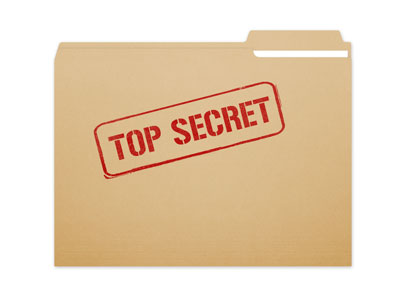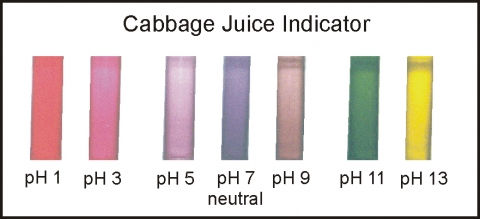How can I write secret messages?
How does this align with my curriculum?
Learn how you can write and reveal secret messages in this hands-on chemistry activity.
What You Need
- Red cabbage
- Knife or food processor
- Stove
- Sieve
- Container (for cabbage juice)
- Paint brushes
- Measuring cup (in mL)
- Spoon
- Baking soda - 60 mL
- Lemon juice - 100 mL
- Milk - 100 mL
- Warm water - 60 mL
- Containers or cups - 3
- Paper (for best results use newsprint, coffee filters, or paper towel)
Safety First!
Be careful working with knives and/or food processor blades. Provide adult assistance or supervision for younger children.
What to Do
Make cabbage juice:
- Cut the cabbage into small pieces or chop in a food processor.
- Boil the cabbage until it is almost colourless and then strain the cabbage juice through a sieve. Discard the cabbage.
- Let cabbage juice cool, and then pour into a container. Set aside for use during the activity or store in a fridge (Note: To save for later use, cabbage juice can be frozen in ice cube trays, creating small batches for separate activities).
Write secret messages:
- Dissolve the baking soda in the warm water and let it cool. This is a saturated solution so there should be some solid material at the bottom of the container.
- Using a paint brush, write a message using the baking soda solution on a piece of paper. Let the picture dry thoroughly. You will not be able to see it clearly.
- On a new piece of paper, use a clean paintbrush to write another message using just lemon juice.
- Repeat the process with milk.
- After the papers are dry, dip another paintbrush into the cabbage juice and brush over the secret messages. What happens?
Discovery
Red cabbage juice looks dark red, or purple, until it comes into contact with an acid or a base. When mixed with an acid, the juice turns pink-red but when mixed with a base, the juice turns blue-green (see image above). The more acidic the sample, the brighter the pink colour it is. The more basic, the brighter the green it turns.
So, even though you wrote messages in liquids that are white or colourless, these changes in the red cabbage indicator enable you to see the messages.
Cabbage juice, grape juice, and many other plant juices are acid/base indicators. There are many different types of indicators we can use and the colour produced depends on the type of indicator used. An indicator changes colour when it comes into contact with an acid or a base. This means that those fruits and vegetables will also change colour according to the acidity of their environment (i.e. the soil or atmosphere), and can be used to determine the amount of acid or base present.
The strengths of acids and bases are measured by using a pH scale, a measure of how acidic or basic a substance is. Using a scale of 0 – 14, acids and bases are on opposite ends (see picture above). Substances with a pH of 0 are said to be very acidic, while substances with a pH of 14 are said to be very basic. Substances with a pH of 7 are said to be neutral – which means they are neither acidic nor basic. Each number represents a 10-fold change in alkalinity or acidity; for instance, when comparing the acidity of lemon juice (pH = 2) to vinegar (pH = 3), lemon juice is ten times more acidic than vinegar, even though their pH values are only 1 pH apart.
Most of the food that we consume is generally acidic, with some exceptions, like egg whites. Acidic food such as apple juice, orange juice, and lemon juice generally taste sour. Water is considered to be neutral, with a pH of 7. Household cleaning solutions, such as baking soda, detergents, and soaps, are examples of bases.
Identifying the pH of a substance is used in a variety of instances:
- Drinking water is tested to be sure it is within a safe pH range to drink.
- Ocean waters are tested to see how weather or pollution has changed the pH to determine if it will become dangerous for the animal and plant life living there.
- If you have a pool, your may have seen your parents testing the water – they may have been using a pH indicator. Pools with a high pH can cause cloudy water. Pools with low pH readings might irritate your skin and eyes.
- Farmers must test the pH of their fields to ensure the acidity/alkalinity of the soil won’t kill their crops.
- Instead of using cabbage juice to reveal the secret messages, try grape juice (not grape drink). Does it work?
- Reverse the process-- paint a piece of paper with cabbage juice and let the paper dry. Then, write messages on the piece of paper. What happens? And what happens if the baking soda and lemon juice mix?
- Try to write secret messages with other liquids, such as apple juice, orange juice, dish detergent, club soda, bubble bath, and egg whites. What happens when you paint the cabbage juice on them?
For more information on this topic check out these Let's Talk Science resources:
- What happens when acids and bases mix? (Hands-on Activities) - Learn about acid-base reactions. Make you own pH indicator and test it with different solutions.
- What is Acid rain? (STEM in Context) - Acid rain is any precipitation that has an unusually low pH. It can be rain, snow, fog, etc. But what is a low pH and why is this a problem?
What’s happening?
Red cabbage juice looks dark red, or purple, until it comes into contact with an acid or a base. When mixed with an acid, the juice turns pink-red but when mixed with a base, the juice turns blue-green (see image above). The more acidic the sample, the brighter the pink colour it is. The more basic, the brighter the green it turns.
So, even though you wrote messages in liquids that are white or colourless, these changes in the red cabbage indicator enable you to see the messages.
Cabbage juice, grape juice, and many other plant juices are acid/base indicators. There are many different types of indicators we can use and the colour produced depends on the type of indicator used. An indicator changes colour when it comes into contact with an acid or a base. This means that those fruits and vegetables will also change colour according to the acidity of their environment (i.e. the soil or atmosphere), and can be used to determine the amount of acid or base present.
The strengths of acids and bases are measured by using a pH scale, a measure of how acidic or basic a substance is. Using a scale of 0 – 14, acids and bases are on opposite ends (see picture above). Substances with a pH of 0 are said to be very acidic, while substances with a pH of 14 are said to be very basic. Substances with a pH of 7 are said to be neutral – which means they are neither acidic nor basic. Each number represents a 10-fold change in alkalinity or acidity; for instance, when comparing the acidity of lemon juice (pH = 2) to vinegar (pH = 3), lemon juice is ten times more acidic than vinegar, even though their pH values are only 1 pH apart.
Most of the food that we consume is generally acidic, with some exceptions, like egg whites. Acidic food such as apple juice, orange juice, and lemon juice generally taste sour. Water is considered to be neutral, with a pH of 7. Household cleaning solutions, such as baking soda, detergents, and soaps, are examples of bases.
Why does it matter?
Identifying the pH of a substance is used in a variety of instances:
- Drinking water is tested to be sure it is within a safe pH range to drink.
- Ocean waters are tested to see how weather or pollution has changed the pH to determine if it will become dangerous for the animal and plant life living there.
- If you have a pool, your may have seen your parents testing the water – they may have been using a pH indicator. Pools with a high pH can cause cloudy water. Pools with low pH readings might irritate your skin and eyes.
- Farmers must test the pH of their fields to ensure the acidity/alkalinity of the soil won’t kill their crops.
Investigate further
- Instead of using cabbage juice to reveal the secret messages, try grape juice (not grape drink). Does it work?
- Reverse the process-- paint a piece of paper with cabbage juice and let the paper dry. Then, write messages on the piece of paper. What happens? And what happens if the baking soda and lemon juice mix?
- Try to write secret messages with other liquids, such as apple juice, orange juice, dish detergent, club soda, bubble bath, and egg whites. What happens when you paint the cabbage juice on them?
For more information on this topic check out these Let's Talk Science resources:
- What happens when acids and bases mix? (Hands-on Activities) - Learn about acid-base reactions. Make you own pH indicator and test it with different solutions.
- What is Acid rain? (STEM in Context) - Acid rain is any precipitation that has an unusually low pH. It can be rain, snow, fog, etc. But what is a low pH and why is this a problem?

